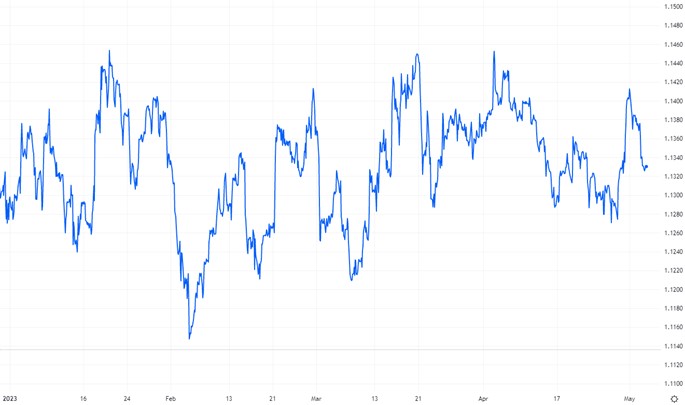GBP-EUR Exchange Rate Heavily Influenced by Interest Rate Speculation in April
The pound firmed against the euro in early April amid market expectations of more interest rate hikes from the Bank of England (BOE) in a bid to quell inflation. This hawkish outlook was reinforced by comments from central bank rate-setters – notably the BoE’s chief economist Huw Pill who didn’t rule out more rate rises.
The GBP-EUR pair’s strength was soon eroded by hawkish rhetoric from the European Central Bank (ECB) and the impact of quiet Easter trading conditions on the pound. A sharp recovery followed but was soon blunted by economic uncertainty after UK data disappointed.
The pound lost its edge following February’s monthly GDP reading which printed at 0% on 13 April, missing the 0.1% forecast. The data prompted a pound selloff as investors were spooked by news that the UK’s service and production sectors had contracted – causing the GBP-EUR rate to plunge into the 1.11 range.
The pound’s headwinds dissipated following the release of the latest consumer price index (CPI) on 19 April, which showed UK inflation remained unexpectedly hot during March. The CPI reading dropped less than expected to 10.1%, missing economists’ forecast for a larger decline in the annual rate to 9.8%. This raised expectations that the BoE will hike its base interest rate in May, propelling the pound into the 1.13 mid-range against the single currency.
The UK currency’s inflation-fuelled strength was already waning when downbeat retail sales and mixed PMI data were compounded by Domonic Raab’s resignation as deputy prime minister on 21 April.
Another sharp recovery for the pound amid renewed BoE rate hike bets was capped by expectations that May could mark the end of the central bank’s policy tightening cycle.
The pair was dragged into the 1.12 range on 26 April by a positive German consumer confidence reading, which rose for the seventh consecutive month to its highest level in over a year – stoking optimism around the ongoing recovery in the Eurozone’s largest economy.
This downward movement left the pound on course for an overall loss against the euro in April.
GBPEUR: Year-to-Date

Looking ahead
The BoE’s Monetary Policy Committee makes its next interest rate announcement on 11 May, with the central bank rate-setters widely expected to hike rates by another 25bps in a bid to tame double-digit inflation. This would represent its 12th consecutive rate hike since commencing its policy tightening cycle in December 2021.
Influential data from the UK economy in May: GDP (12 May), ILO unemployment rate (16 May), CPI (17 May), services PMI (23 May).
The ECB is expected to hike interest rates for a seventh straight meeting on 4 May, with policymakers signalling a 25bps increase – rather than a larger 50bps move.
Investors in the euro will be monitoring events in Ukraine after Russian military aircraft were intercepted by German and British pilots in international airspace over the Baltic Sea. The news compounded fears that Russia may drag its ally Belarus into the war.
Concerns about the potential collapse of another US bank – First Republic – are spreading into European markets. Subsequent anxiety over fresh banking sector turmoil could hamper the euro in May.







